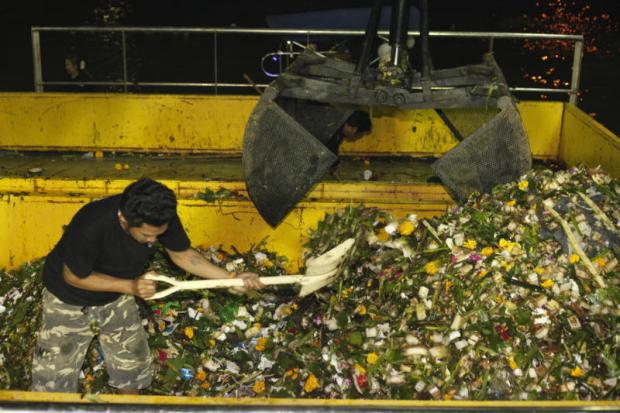
The amount of garbage collected from Bangkok's waterways following the Loy Krathong festival was still high at more than six tonnes.
On the plus side, most people opted to use krathong made from natural materials such as bread.
Nationwide, the number of krathong collected was substantially lower than last year. Many people instead opted for a quiet, more private celebration, with families floating their krathong on village and farm ponds.
Bangkok city governor Aswin Kwanmuang said 661,935 floats were collected from waterways across Bangkok early yesterday. Of these, 617,901 (93.7%) were made from natural material that could decompose, while 44,034 were styrofoam floats, he said.

There were 163,679 fewer krathong collected than last year, but the total still amounted to over six tonnes of rubbish.
Bangkok deputy governor Jakkrapan Phiewngarm said there were 20% fewer floats made from styrofoam than last year while the number of floats made from natural materials increased by 91%, he said.
Last year, a total of 825,614 krathong were collected. Of these, 754,587 were made from natural materials, while the rest were styrofoam.
The deputy governor said floats made from natural materials would be turned into fertiliser at the Nong Khem garbage disposal centre. The styrofoam floats will be sent for recycling. City authorities kept 30 public parks open for people to float their krathong on Monday night.
The Bangkok Metropolitan Administration deployed 210 workers, along with 45 boats, to collect floats from the Chao Phraya River and other waterways from 8pm on Monday until midnight. Collections resumed later yesterday morning with nine trucks being used to take the natural floats to the Nong Khem garbage centre.
Lat Krabang district saw the highest number of floats collected this year, while Pomprap Sattruphai had the smallest number, according to Daily News Online.
In the provinces, local authority workers and volunteers also cleaned up rivers, ponds and canals following the festival. In Nakhon Ratchasima municipality, 50 workers collected krathong from the moat in the town centre near the Thao Suranaree Monument. The moat is the most popular place to float among residents celebrating the festival.
In Buri Ram, more than 200 workers and volunteers in Muang district cleared at least 20,000 krathong from the town's moat.
Buri Ram mayor Kamol Ruengsuksriwong said 30% of the floats were made of non-biodegradable styrofoam. He said krathong made from styrofoam and other environmentally unfriendly materials will be banned next year.
In Lampang, more than 100 students and teachers from the Institute of Physical Education helped municipal workers clean up the Wang River in Muang district. Nakhon Lampang mayor Kittiphum Namwong said he was pleased that many people in the town showed environmental awareness by floating krathong made from natural materials such as sliced banana trunk and leaves.
Lampang collected eight tonnes of krathong this year, three tonnes less than last year. The mayor said the ban on entertainment activities following the passing of His Majesty discouraged people in villages from travelling to the town centre.